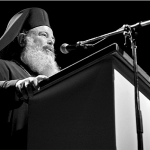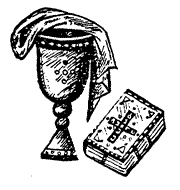By Fr. John A. Peck
Part One of a Five Part Series
A Short History of the Liturgical Location for Preaching: The Ambo, the Pulpit and the Lectern
 Throughout history, the place occupied by the preacher has changed based on liturgical and theological need.
Throughout history, the place occupied by the preacher has changed based on liturgical and theological need.
Primarily of course, the purpose of changing the location was of necessity – to be seen and heard by those listening and looking. Our Lord Himself ascended a mountain for the “Sermon on the Mount” (hence the name) and often spoke where more to could hear and see Him more clearly.
This is a study, a very humble study, of how the Church liturgically and architecturally has provided a location to proclaim the message of salvation in Christ Jesus.
Introduction
In most contemporary Orthodox Churches, the preacher usually delivers his homily from the ambo – the semicircular extension of the area in front of the Royal Doors. Without too much difficulty, it is done here so that most everyone in the Church can see and hear him.
From the earliest days of human history, those who speak publicly stood in a place where they could be both seen and heard better. Proclamation of the Gospel has fared likewise, and architecturally this has been born out in our Churches in different ways throughout history.
We see it even now in the mini-mega-Churches whose sanctuaries are bereft of any Christian imagery or symbolism, yet the pastor or speaker (or drama ministry team or praise band) is on a stage. Where everyone can see and hear them easily.
In Orthodox Christian architecture and liturgy, this has classically followed secular solutions to the problem and adjusted these based on liturgical need.
In all cases, the purpose was not to separate the speaker or preacher from the crowd of listeners, but to unite them, and bring them closer to each other, able to see and hear each other with greater acuity.
Why bother?
“Why bother with places to preach? The principle liturgical action of the Church is the Eucharist.”
 The truth is, the liturgy is not all about the Eucharist.
The truth is, the liturgy is not all about the Eucharist.
It’s about the Gospel and the Eucharist.
On every Orthodox Christian altar is the Gospel Book and it remains there. The Chalice is only brought forward and placed upon the altar during the Great Entrance, but the Gospel book remains.
The Liturgy of the Word comprises the first part of the liturgy, and the Liturgy of the Eucharist, the Eucharistic Anaphora, the second part. It has been this way from the beginning, and this is because in the Christian service of worship there is one fact which underlies everything else:
The Gospel proclaims the Eucharist, and
the Eucharist proclaims the Gospel.
Either without the other leads to distortion of the Gospel message and vision of the Church. Together, they provide earth with a place where heaven has invaded the earth.
In Orthodox Churches for some time, preaching the Gospel of Christ has taken a serious backseat to the liturgical celebration of the Eucharist. (this is evident in the lack of homiletics preparation available, let alone mandatory, at contemporary Orthodox theological seminaries). However, in this context it is easily forgotten that the word is preached in a liturgical setting.
Secondly, some priests have taken it upon themselves to wander around the Church while preaching, or walking to and fro, up and down the aisles. Several blog articles by Roman Catholic authors have addressed this; here, here and here.
Among the comments was this, by “Fr. Z”‘
“I suppose the roving preacher in the Catholic Church comes from the imposition of the man’s own personal quirk on the people of God. This may be in imitation of Protestants, who almost by the very nature of much Protestant preaching need to impose their own personality on the sermon.
In my opinion and experience, the preacher who does this is a narcissist. He is drawing attention to himself. He imposes himself, overlays himself, for his own needs, on the rite, the Word of God, and the people. His needs first… every else? Forget it.
Are there exceptions? Of course. But not many.”
I could not agree more.
The reason we chant the Scriptures is to remove our own personality from the reading – to let the words of the Scriptures speak for themselves. Likewise, the imposition of our own personalities – drawing attention to ourselves during preaching – is a disaster, and not the Orthodox theological tradition.
We must return to a vibrant and dynamic liturgical setting for preaching. The Church has always made provision for this in the past, and this is the purpose of this article – to describe how the Church in history has provided, architecturally, for one of the two most important liturgical events in the life of the Christian. It was considered important enough to be a central fixture of any Cathedral, permanently installed, intricately and expensively adorned. It was not to be overlooked, ignored or accidentally ‘missed’ in the flurry of liturgical action.
Form is determined by function architecturally (I will, of course, cede any statements about architecture to architects, but none that I contacted wanted to write an article), and Church space is no exception. In the Orthodox tradition, Church architecture is significant and unique, being formed by Incarnational theology.
“In the beginning was the Word,”
– after all.
Some definitions.
In this series of articles, though these terms are often used interchangeably, for clarity’s sake we will adhere to some specific definitions, and point out that there is a basic difference between an ambo, a pulpit, and a lectern.
An ambo is elevated, freestanding, and rectangular in shape, and is approached from the side or from behind by stairs.*
A pulpit is attached to part of the building (such as a pillar), is elevated, and surrounds the preacher except from behind where the stairs connect.
A lectern is a freestanding, portable device which is often placed on a freestanding podium.(A common faux-pas: a podium is not synonymous with a lectern, but is simply a portable box designed to elevate a lectern. That is, one stands on a podium but stands at a lectern.)
*The ambo of most Orthodox Churches has been reduced to the hemispheric projection of the bema or soleas which faces west in front of the Royal Doors. In contemporary usage, the bema itself is composed of the altar or sanctuary (the area behind the iconostas), the soleas (the pathway in front of the iconostas), and the ambo (the area in front of the Holy Doors which projects westward into the nave).
By these definitions, what are sometimes called pulpits are actually lecterns, and what are sometimes called pulpits are actually small ambones. These terms are often used interchangeably, and we simply want to set some particular definitions for the purposes of this article.
So, if you have a small ambo and it has always been called a pulpit, that is fine.
If you have a lectern, and it has always been called a pulpit, that is fine, too.
Compiled from various sources
Part Two can be read HERE.
